With the beginning of the 1941-42 film season, no one could look into the future and see what would happen. It took a while for wartime references to get into the cartoons. By the end of that season, there were not only occasional references to the ongoing conflict, but entire cartoons inspired by it. Meanwhile, the Merrie Melodies were exceedingly popular, while the Looney Tunes may not have been as popular as they once had been.
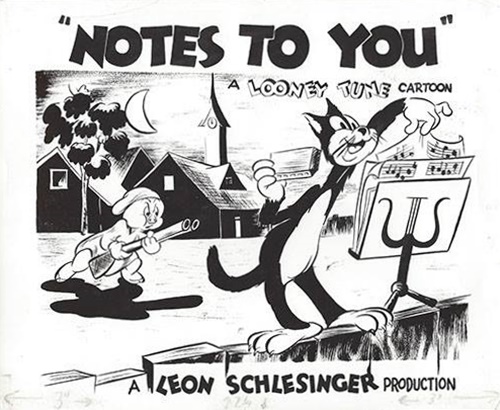
Notes To You (9/20/41) – A musically inclined kitty-cat, serenading on the fence, keeps Porky awake at night. Porky throws books, shoes, vases, and everything else he can find, and eventually “offs” the cat – but lives to regret it, as the cat’s ghosts form an entire opera company. The musical program includes Brahms’ Lullaby”, “Largo al Factotum” from Rossini’s Barber of Seville, “Frat”, “Jeepers Creepers”, “Aloha Oe”, “Make Love With a Guitar” (recorded by clarinetist Tommy Reynolds (“Your Band of Tomorrow” on Vocalion, Bob Chester on Bluebird, Carlos Molina on Philharmonic, Jan Savitt on Decca, Johnny Messner on Varsity, Horace Heidt on Columbia, Sammy Kaye on Victor, and in England by Harry Roy on Regal Zonophone, and airchecks by Ted Weems with Perry Como on vocal (below) and by Dennis Day), and finally closing the film with Donizetti’s Sextet from Lucia Di Lammermoor.
Robinson Crusoe Jr. (10/25/41) – Porky does the Robinson Crusoe bit, and eets up with a “Rochester”-voiced Man Friday along with other more threatening natives. A gurst sign of wartime references has the natives’ spears refuse to cause damage to Porky and his boat when Porky and Friday hand out an American flag. Songs include “Blow the Man Down”, “A Life On the Ocean Waves”. “Nagasaki”, and a full verse production number of “Java Jive”, a recent hit for the Ink Spots on Decca, also existing as an outtake on a Universal Pictures disc from Abbott and Costello’s “Pardon My Sarong”, and one of their few successes not using their ballad style with falsetto tenor lead. Cover versions appeared by the Four King Sisters on Bluebird, and Al Donahue on Okeh. It received a revisit circa 1950 by the Modernaires on Columbia. In more recent years the number was revived by the Manhattan Transfer.

Porky’s Midnight Matinee (11/22/41) – The pygmy ant returns, engaging in a backstage chase in a movie house with janitor Porky. His value in dollars, depicted on the bottom of his cage, has shot up dramatically from his first appearance in Porky’s Ant, though not quite reaching the number of zeroes in the price tag for Pory’s dodo bird. Songs: “You Ought To Be In Pictures” and “Java Jive”.
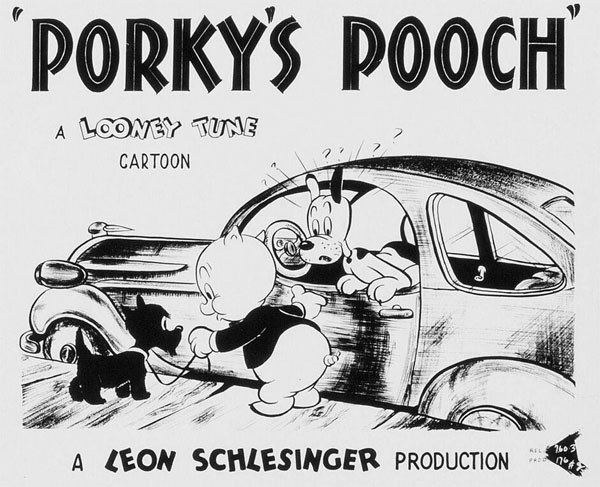
Porky’s Pooch (12/27/41) – The origins of a proto-Charlie Dog, up to his usual tricks in finding a “master”, barging in on Porky, who is clad only in a bath towel. The animators seem to have slipped one past the censors – read closely the lips of Charlie when he is locked outside the window for a surprising dialogue revelation! As usual, “Where, Oh Where Has My Little Dog Gone” appears, along with “Singing in the Bathtub”, and a newcomer, “Caballero”, a recent original performed by Ann Sheridan in the James Cagney/Pat O’Brian reteaming, Torrid Zone, but here used by Charlie Dog for an impersonation of Carmen Miranda. The song seems to have gone nowhere, with no known commercial recordings.
Note in the Torrid Zone clip below – at :21 – is Leo White, whom we will see on screen in Clampett’s Eatin’ On The Cuff, later this season.

Porky’s Pastry Pirates (1/17/42), appears to be all original score. Plot features a salute to the venerable Jimmy Cagney, cast as a tough-guy bee giving a fly a few “pointers” on how to invade Porky’s Sanitary Bakery. Ultimately, however, even a tough guy has to take his lumps. Songs: “You Hit My Heart With A Bang” and whistled by Porky, “Are There Any More At Home Like You?”.
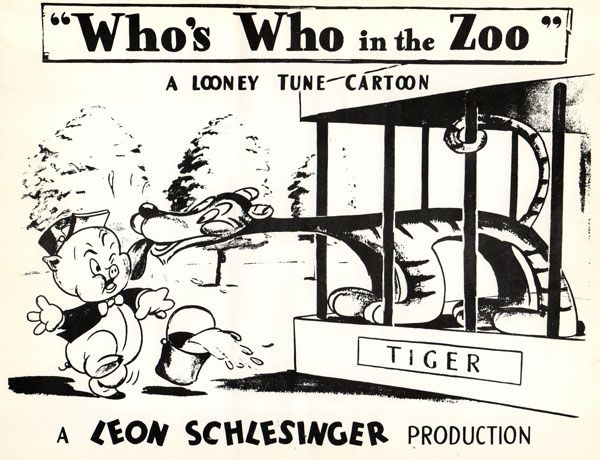
Who’s Who At the Zoo (2/14/42) – Possibly Norman McCabe’s directorial debut. Another zoo spot-gag reel, with Porky barely present, appearing only in a couple of sequences, delayed until almost halfway into the film. Songs: “You Ought To Be In Pictures”, and “You, You Darlin’”, recorded by Duke Ellington for Victor, Jack Teagarden for Varsity, Bob Crosby on Decca (below), Blue Barron on Bluebird, and Jimmy Dorsey on V-Disc.
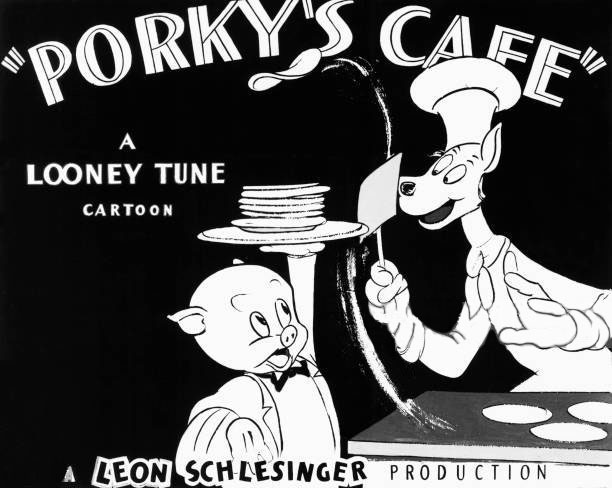
Porky’s Café (2/21/42) – Porky tries to serve breakfast to a strange little man, while chef Conrad Cat does battle with pancakes and an ant in the kitchen. Musical program includes the Pizzicato fron “Sylvia”, “Start the Day Right”, and “Keep Cool, Fool”, recorded for Decca by Ella Fitzgerald and her Famous Orchestra (the remnants of the former Chick Webb band after their drummer/leader died), Erskine Hawkins on Bluebird, Les Brown on Okeh with vocal by Doris Day, Jan Savitt on Victor, Raymond Scott on Columbia (for once, playing something he didn’t write), and the Ink Spots on Decca.
Saps In Chaps (4/11/42) – Spot gags on cowboy life. A Western omelette of songs includes “Cheyenne”, “Oh, Susannah, “California, Here I Come”, the studio’s original “I Can’t Get a Long Little Dogie” previously used in “A Coy Decoy”, Von Suppe’s “Light Cavalry Overture”, “Ride, Tenderfoot, Ride”, and out of the blue, one of the first uses of the patriotic wartime ditty, “We Did It Before and We Can Do It Again”, recorded commercially by Dick Robertson on Decca, and by Carl Hoff on Okeh (backed on the flip side with another cartoon anthem to be used by a rival studio – You’re a Sap, Mr. Jap).
Daffy’s Southern Exposure (5/2/42) – Daffy decides not to fly South for the winter – having seen a calendar with a shapely young thing dressed for a winter festival. He eventually realizes the error of his ways when he encounters a cabin full of beans – inhabited by a fox and weasel who’d much prefer to have a duck dinner. Daffy winds up flying South all right – way down South – to Brazil, where he nestles in the tutti fruitti hat of a Carmen Miranda wanna-be. The score includes “Shoo Fly, Don’t Bother Me” (with special lyrics), “When the Swallows Come Back to Capistrano”, “We Did It Before and We Can Do It Again” and “The Latin Quarter” (with special lyrics – “What Is Your Order?”):
Also heard (and sung) is “The Gaucho Serenade”, performed by Ann Sheridan in the Warner picture “It All Came True”. The latter song received several recordings, including Paul Whiteman on Decca, Glenn Miller on Bluebird, Frankie Masters on Okeh, Johnny McGee on Varsity, Roy Smeck and his Hawaiians on Decca, and vocal versions by Dick Todd on Bluebird (below) and the Charioteers on Columbia (later revived on MGM under the name of the group’s lead singer, Billy Williams). It also extended into the European market with Joe Loss on Regal Zonophone, Fud Candrix in occupied Brussels on Telefunken, and Harry Roy on Parlophone. Some late revivals included the Ames Brothers on Coral, David Rose on MGM, and Steve Gibson and the Red Caps with Damita Jo on ABC Paramount. Gene Autry would even issue a feature under the song’s title.
Nutty News (5/23/42) – A newsreel spoof with some wartime gags – a “Hitler in the Box” in a barber shop to scare the kids’ hair into standing on end for an easy cut. Song program includes “Tales of the Vienna Woods”, “Dixie”, “A Hunting We Will Go”, “Congo”, and “Says Who? Says You, Says I!”, a number from Warner’s feature “Blues in the Night” (below), recorded by Cab Calloway on Okeh and Glenn Miller on Bluebird. The number would receive more extended use by Stalling in the Merrie Melodies Bugs Bunny epic, Wabbit Twouble, in the same season.

Hobby Horse Laughs (6/6/42) – Spot gags on hobbies, inspired by the “Hobby Lobby” radio program.. Songs on the track include: “My Bonnie Lies Over the Ocean”, “Arkansas Traveler”, and “Keep Cool, Fool.”
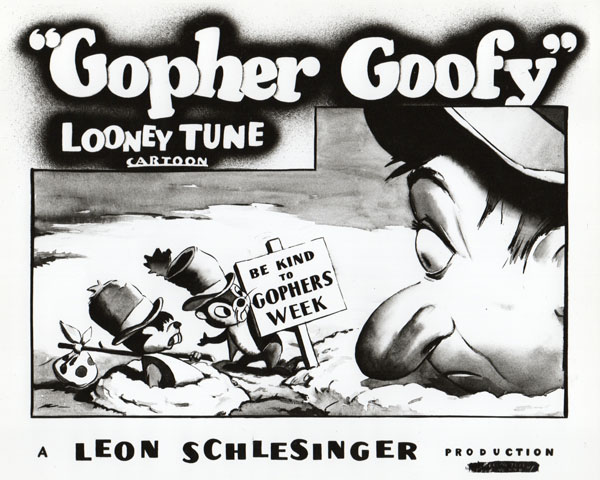
Gopher Goofy (6/27/42) – Two Brooklynese gophers go to the country for better surroundings and farm-fresh food (though one still prefers the surroundings of Central Park). They do typical battle with a farmer bent on their extermination. Not a progenitor of the later “Goofy Gophers” series. Songs include “Piggy Wiggy Woo”, and “Goodnight, Ladies”.

Wacky Blackout (7/11//42) – Spot gags on how the home front is being affected by the ongoing war. Songs include “Rock-a-Bye Baby”, “Yankee Doodle”, “When the Swallows Come Back to Capistrano”, “My Bonnie Lies Over The Ocean”, “We Did It Before…”, and a current newcomer, “Blues in the Night”, featured in the Warner feature of the same name, and performed in the picture by one of its most successful recorders, Jimmie Lunceford and his orchestra, who recorded a two-sided extended arrangement on Decca (his soundtrack version was also issued on a special promotional 12″ 78 by the Warner Studio itself). Other commercial recordings included the Benny Goodman Sextet on Okeh with vocal by Peggy Lee, Cab Calloway on Okeh, Woody Herman on Decca, Harry James on Columbia, Dinah Shore on Bluebird, Bing Crosby on Decca (below), Judy Garland on Decca with later version by Johnny Mercer, Jo Stafford and the Pied Pipers on Capitol, and Larry Adler on Decca.

The Ducktators (8/1/42) – Very dated spoof of stereotypes of Hitler, Hirohito, and Mussolini, as two ducks and a goose, respectively. Wartime parable of the rise of the dictators leading to WWII. Lots of politically incorrect humor, including the Japanese Duck attempting to capture a turtle as a “mandate island”, then hiding his nationality with a button reading “I am Chinese (Made in Japan).” Songs: “We Did It Before and We Can Do It Again”, “Blues In the Night”, and “Japanese Sandman” with special (and insulting) lyrics.
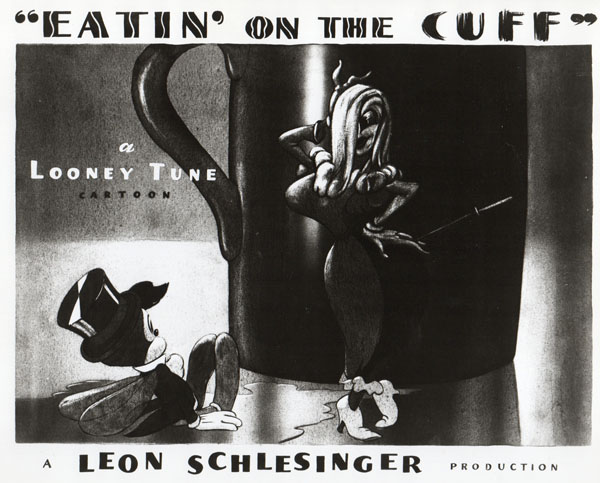
Eatin’ On the Cuff (8/22/42) – A mix of live action and animation, as a stage pianist (actor Leo White – dubbed by Mel Blanc) tells the tale of a moth in love with a honeybee, but in turn being pursued by a Widow Spider (another parody of the man-hungry characters of Brenda and Cobina (Blanche Stewart and Elvia Allman) from Bob Hope’s Pepsodent show). The widow tries to tempt the moth with flame, but honeybee comes to the rescue as a “Bee-19″ (“Confidentially, she stings”). When the human narrator expresses dubiety over the story, the moth responds by consuming his trousers, exposing his plaid boxer shorts for the fade out. An original song, based on a tune called “A Moth And His Flame”, provides portions of the narration – and other oldies include “Frankie and Johnny”, the “Wedding March”, and “Shortnin’ Bread” (with special lyrics).
NEXT: the 1941-42 Merrie Melodies.


 James Parten has overcome a congenital visual disability to be acknowledged as an expert on the early history of recorded sound. He has a Broadcasting Certificate (Radio Option) from Los Angeles Valley College, class of 1999. He has also been a fan of animated cartoons since childhood.
James Parten has overcome a congenital visual disability to be acknowledged as an expert on the early history of recorded sound. He has a Broadcasting Certificate (Radio Option) from Los Angeles Valley College, class of 1999. He has also been a fan of animated cartoons since childhood.











































Stalling re-uses a lot of his score from “Elmer’s Candid Camera” for “Gopher Goofy”, as if still being in B&W, the Looney Tunes are suffering from second-class status more and more, as audiences want color cartoons (and with Avery’s departure, the seeming original 1940-41 season plan to have all four directors share in handling the Looney Tunes goes out the window by the end of the ’41-’42 season, with McCabe as the newest director getting the bulk of the B&W assignments).
I much prefer the Modernaires’ recording of “Piggy Wiggy Woo” over the previous one!
The spider in “Eatin’ on the Cuff” may have been based on characters on the Pepsodent Show; but when she’s shown with her blond hair hanging down over half her face (as in the lobby card), that’s a caricature of Veronica Lake, who was at the height of her stardom in 1942. She was a popular pin-up girl with G.I.s, but her career began to decline after she played a Nazi spy in “The Hour Before the Dawn” (1944). My parents used to call me “Veronica Lake” whenever they thought I needed a haircut.
“The Ducktators” derives much of its score from the “Dance of the Comedians” from Bedrich Smetana’s comic opera “The Bartered Bride”, the first great Czech opera and by far the one most frequently produced internationally. (Also, the introduction to “Poet and Peasant” accompanies the musings of the dove of peace.) Stalling would use it in many other cartoons, especially those featuring the Road Runner. The Dance accompanies the arrival of a circus troupe in Act III and could with equal justice be translated as “Dance of the Clowns”, which perhaps explains its prominence in this cartoon.
By the way, for those who have never heard the composer’s name spoken out loud, it’s pronounced “SMET-ana”. If you place the emphasis on the second syllable — “Smet-AN-a” — it means “sour cream”.
Other songs not mentioned:
Who’s Who at the Zoo: “The Merry Carousel” by Frank Weldon, played during the ice cream gag.
Porky’s Cafe: “Tica ti – Tica ta” by Louis Prima, heard during the coffee, egg and toast sequence. Heard in a few other LT shorts of the time… and over a decade later in 1953’s “Muscle Tussle” for some reason. “Happiness Ahead” by Allie Wrubel is also heard, when the ant emerges from the sugar: https://www.youtube.com/watch?v=FZGdPdxRSIQ
Daffy’s Southern Exposure: “Hang on to Your Lids, Kids” is also heard, during the chase sequence.
Hobby-Horse Laffs: “Götterdämmerung” by Richard Wagner, which plays when Professor Blooper appears: https://www.youtube.com/watch?v=UfRyZIN_HWw . Notably in that sequence, Professor Blooper is basically Mel Blanc’s regular speaking voice.
Also, “She Was an Acrobat’s Daughter” plays during the flight sequence. A shame that song never carried over to the “silver age” WB shows- it’s a fun little melody.
Other comment: “Says Who? Says You, Says I!” is one of my favorite songs used in Looney Tunes, but it was barely featured at all, only a small handful of times. It’s one of the reasons why the otherwise mediocre “The Bird Came C.O.D.” is so enjoyable – it’s heard for over a full minute at the start of the cartoon.
Thanks for the additional information.
For the record (and no pun intended), James’ “Needle Drop Notes” posts are not designed to be complete cue sheets for each cartoon – but are simply presented to highlight significant tunes heard on the cartoon soundtracks.
Additional information is always welcome in the comments.
Boy, they sure used “We Did It Before” a lot over at Termite Terrace, didn’t they? Anything to keep up morale, I guess.
“Notes to You” would, of course, be remade as the much better known — and just plain better, in my opinion — “Back Alley Op-Roar”, with Elmer and Sylvester. Great use of music on that cartoon, especially the Spike Jones-esque rendition of “Angel in Disguise”.
“Dear Little Boy of Mine”‘s featured at the near-end of “Poerky’s Pooch”. Used as far back as “I’d Love to take orders from You” and thru and even at the END of “Who’s Kitten Who?” By our ol’frined..Egbert Van Alstyne.
From Porky’s Hired Hand (1940) to Puss n’ Booty (1943), all the B&W Looney Tunes are in the public domain EXCEPT Porky’s Snooze Reel (1941). Any idea why this is?
Unless you’re referring to a different tune, in Porky’s Cafe, when Conrad the Cat’s making pancakes toward the beginning, the tune that’s being played is Gossec’s “Gavotte”, which Stalling often used in his scores, not the Pizzicato from Sylvia.
Please, can someone tell me which cartoon has the song 1,2,3,O’leary?I 1st thought it was Omalley– someone is playing hide and seek and singing this. typical looney tunes or merrie melodies